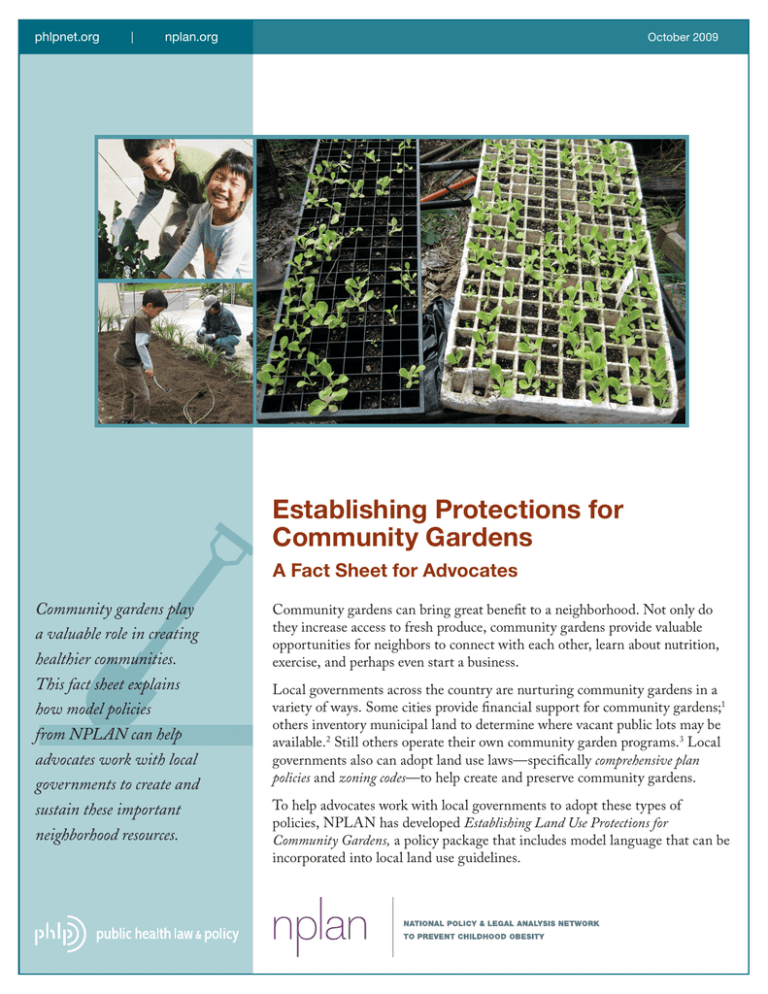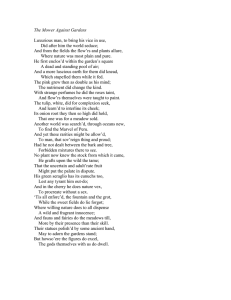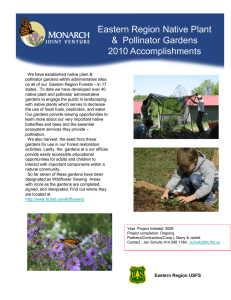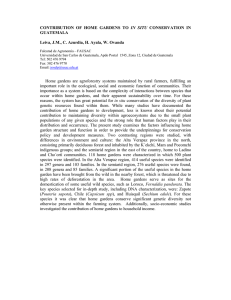Establishing Protections for Community Gardens A Fact Sheet for Advocates Community gardens play
advertisement

phlpnet.org I nplan.org October 2009 Establishing Protections for Community Gardens A Fact Sheet for Advocates Community gardens play a valuable role in creating healthier communities. This fact sheet explains how model policies from NPLAN can help advocates work with local governments to create and sustain these important neighborhood resources. Community gardens can bring great benefit to a neighborhood. Not only do they increase access to fresh produce, community gardens provide valuable opportunities for neighbors to connect with each other, learn about nutrition, exercise, and perhaps even start a business. Local governments across the country are nurturing community gardens in a variety of ways. Some cities provide financial support for community gardens;1 others inventory municipal land to determine where vacant public lots may be available.2 Still others operate their own community garden programs.3 Local governments also can adopt land use laws—specifically comprehensive plan policies and zoning codes—to help create and preserve community gardens. To help advocates work with local governments to adopt these types of policies, NPLAN has developed Establishing Land Use Protections for Community Gardens, a policy package that includes model language that can be incorporated into local land use guidelines. 2 Establishing Protections for Community Gardens Comprehensive Plan Policies 1 For example, Madison, Wisconsin, has used Community Development Block Grants funds to support community gardens. See www. ci.madison.wi.us./cdbg/docs/brochure_G. pdf. Likewise, Los Angeles, California’s Community Redevelopment Agency also funds community gardens as part of the City’s effort to become the “greenest” major city in the nation. See www.crala.org/internet-site/ About/Green_Urbanism.cfm. Other cities, such as Boston, are using land trusts to acquire and preserve community gardens. See www. bostonnatural.org/communitygardens.htm. 2 See, e.g., Washington, DC, Code § 48-402(1) (West 2009); Hartford, Conn. Municipal Code § 26-15(a)(1)(2008). 3 For example, San Francisco operates 40 community gardens on city-owned property. More information is available at: www.sfgov. org/site/recpark_page.asp?id=27048. 4 83 Am. Jur. 2d Zoning and Planning § 17 Most communities have what is known as a “comprehensive” or “general” plan, which sets guidelines for the types of land uses allowed in different areas within the community. The comprehensive plan describes how the locality is currently using land and makes recommendations for the future,4 addressing factors such as transportation, traffic circulation, housing, park and recreation areas, and public facilities. Local governments can support community gardens by including a policy in the city’s comprehensive plan to create and sustain community gardens. NPLAN’s Model Comprehensive Plan Language has two specific goals—to protect existing community gardens and establish new ones—and it sets forth explicit actions a community should take to fulfill these goals. Zoning Codes A community’s zoning regulations are essentially an interpretation of the policies laid out in the comprehensive plan. Simply put, zoning determines what can and cannot be built, and what activities can and cannot take place, on different parcels of land. Most cities have what are known as “use-based” zoning laws, meaning the jurisdiction is divided into distinct districts such as residential, commercial, multi- or mixed-use, or industrial. These designations determine how the land can be used. The problem is that zoning codes do not usually address community gardens, leaving them vulnerable to being closed down as an “illegal” use. To resolve this issue, NPLAN’s Model Zoning Ordinance Language for Community Gardens provides local governments with two options. One option establishes community gardens as an approved use of land in residential, multi-family, mixed use, industrial, or any other zone the community selects. This allows residents to set up community gardens without obtaining a permit or other prior approval from the government. The second option provided in NPLAN’s model ordinance language protects community gardens established on public property. This option sets up a separate subcategory (or “subdistrict”) of open space designated for use as community gardens, giving community gardens the same protections as other types of open space uses. Conclusion Community gardens play a valuable role in creating healthier communities— but to be sustainable, they need support from local governments. There are many ways in which local governments can provide that support, from financial aid and land acquisition assistance to adopting “community garden– friendly” land use policies. Establishing Land Use Protections for Community Gardens, a policy package from NPLAN, is designed for policymakers to promote community gardens by helping residents create and sustain these important local resources. Visit www.nplan.org to download Establishing Land Use Protections for Community Gardens, a policy package from NPLAN. The National Policy & Legal Analysis Network to Prevent Childhood Obesity (NPLAN) is a project of Public Health Law & Policy (PHLP). PHLP is a nonprofit organization that provides legal information on matters relating to public health. The legal information provided in this document does not constitute legal advice or legal representation. For legal advice, readers should consult a lawyer in their state. Support for this fact sheet was provided by a grant from the Robert Wood Johnson Foundation. Photos Courtesy of Redwood Heights School Garden OUSD and Kim Arroyo Williamson




